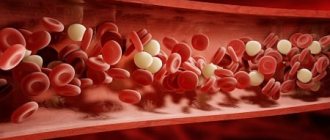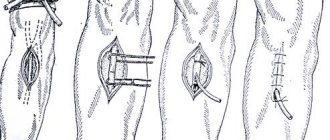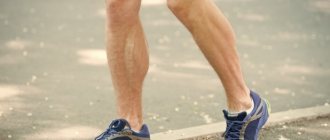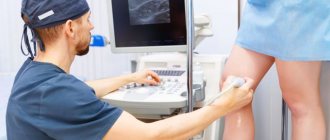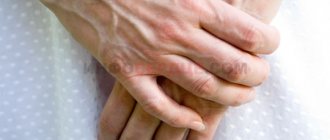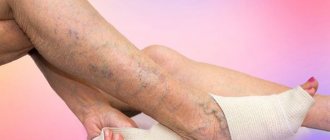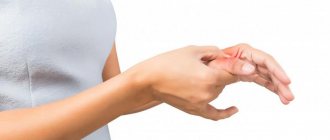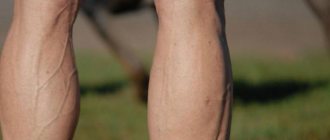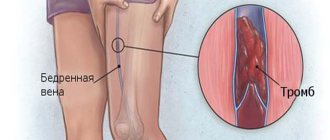Symptoms
If you are wondering whether there may be varicose veins in your arms and suspect you have the disease, pay attention to the signs of the disease
:
- On the hands
. On the back of the hands, patients have bulging dark blue veins. Some veins are lumpy along their entire length up to the elbow. The appearance of the veins is embossed and ugly. - on the palms
, around which blueness is visible, and the appearance of the skin worsens. - Varicose veins on the
fingers are characterized by an increase in the size of the veins between the fingers. The swelling of the veins is also noticeable on the fingers themselves. - Varicose veins on the hands with bumps
are an advanced form of the disease in which the nodes on the veins become visible to the naked eye.
Stagnation of blood in the veins causes pain and discomfort. The upper limbs begin to respond to weather changes. There is numbness and cramps after sleep.
Patients complain of deterioration in hand motor skills: difficulties arise in performing work that requires finger dexterity. It becomes difficult for the sick person to hold things in his hands.
Causes
Provoking factors for varicose veins on the hands are:
- Disruption of the venous valves.
- Hard work with your hands.
- Extensive physical activity (sports training).
- Long-term use of OK (oral contraception).
- Hormonal imbalance during menopause.
- Genetic factors (predisposition if someone has been sick in the family).
- Overheating.
- Smoking and alcohol abuse.
- Obesity and metabolic disorders.
Treatment
Varicose veins on the hands are not dangerous to health
. Surgeons rarely prescribe surgery. Pharmaceuticals, laser and ultrasound treatments are more often prescribed.
During the treatment of varicose veins on the hands, you should use fixing bandages or tight clothing and gloves. Do not overuse physical labor, so as not to cause swelling.
Treatment of varicose veins on the arm should not be postponed until later, so as not to trigger the disease and avoid inflammation and thrombosis.
Effective treatment for varicose veins on the hands
includes:
- Compliance with medical recommendations (external and internal medications).
- Moderate physical activity.
- Cold and hot shower.
- Gymnastics for better blood circulation.
- A low-fat diet without preservatives and blood thickening products.
- Maintaining temperature conditions.
- Quitting alcohol and tobacco.
It is better to treat varicose veins of the hands comprehensively
: warming up the hands improves the condition of blood vessels, and ointments and gels help achieve a good cosmetic effect.
Venotonic drugs are prescribed by a doctor.
Sometimes sclerotherapy is prescribed - a non-surgical procedure for treating vascular pathology. This is a fairly young technique.
Administration of the drug is painless
and brings
quick tangible results
.
Pills
To improve vascular tone, increase blood circulation and reduce vascular fragility, tablets are used for varicose veins of the hands:
- Venarus, Aescusan, Phlebodia, Troxevasin, Venoturon.
- Blood thinners: Venolife, Lyoton, Trental, Warfarin.
- Heparin helps eliminate blood clots and reduce the likelihood of them forming.
- Painkillers: Diclofenac, Ketorol, Indomethacin.
Homeopathic remedies and vitamin complexes are taken along with the tablets (they should contain vitamins C and E). Microelements for maintaining health – silicon and zinc.
Creams and ointments
Ointments and creams for varicose veins help in the fight against the disease. They are used in complex therapy - tablets are combined with external treatment.
Application of ointments is simple - they spread well on the skin
. One of the most inexpensive ointments is heparin. It helps improve blood circulation in the extremities, relieves swelling and has an analgesic effect.
- Gepatrombin and Lyoton penetrate into the deep layers of the skin and relieve pain, inflammation, and resolve blood clots.
- Troxerutin reduces the fragility of capillaries, relieves heaviness in the hands, improves the condition of blood vessels, compacting their walls. The gel is rubbed into the hands or compresses are made.
- Cream-wax “Zdorov” based on bee products is beginning to be used at the stage of varicose veins in the treatment of varicose veins of the legs. You can apply cream to your hands when the first symptoms appear. It contains natural ingredients: beeswax, horse chestnut extract, propolis, olive oil. It has anti-edematous and analgesic properties.
Similar drugs also help in the fight against the disease: Antistax, Varicobooster, Troxevasin, Menovasin, Vishnevsky ointment, ichthyol ointment, Horsepower gel, Sophia cream, Siberian Health balm, gel 911, turpentine ointment.
Diagnosis and drug treatment of affected vessels
Only a qualified doctor can make a diagnosis based on an ultrasound examination, blood test and a number of additional studies. In order to get rid of a problem that causes not only physiological, but also aesthetic discomfort, you need to competently approach the treatment of pathology. In the early stages, it is prescribed to wear special sleeves or gloves that normalize blood flow in the extremities.
There are several effective methods for treating varicose veins in the arms:
- drug therapy;
- laser correction;
- sclerotherapy;
- surgical intervention;
- hirudotherapy;
- folk recipes.
Each method has its own characteristics and is used in a specific case. At the early stage of varicose veins, a conservative method of therapy is prescribed, as a rule, these are venotonic drugs that improve blood circulation in damaged vessels: Venarus, Venen, Pilex, Diosmin, Detralex, Diovenor 600. In order to reduce swelling, relieve pain and eliminate bluishness of the skin apply external agents - ointments, gels and compresses:
- Venoruton;
- Lyoton;
- Troxerutin;
- Venitan;
- Venozol;
- Varicobooster.
The above medications should only be used as prescribed by a doctor, as they may contain substances that can cause allergies and negatively affect the patient’s condition.
Traditional treatment
Traditional medicine knows several ways to combat varicose veins on the hands.
These include compresses with badger fat, treatment with leeches, rubbing with horse chestnut or Kalanchoe tincture, and baths with pine oil.
To relieve pain, drink decoctions of medicinal herbs: calendula, nettle, chamomile.
Folk remedies are used together with traditional treatment
: compresses from fern, tomato, willow branches, cabbage, honey. Rub with medical alcohol and apple cider vinegar.
- It is recommended to wear compression garments during the day and apply a warming bandage at night.
- Treatment of varicose veins of the hands at home should be agreed with a doctor.
Ointment recipe
Do-it-yourself ointment for varicose veins is made as follows:
- Take a tablespoon of rendered lard and mix in equal proportions with Vishnevsky ointment, honey, aloe and onion juice.
- Bring to a half-boil in a water bath.
- Immediately remove the homemade ointment from the heat and cool to 37 degrees.
- Warm ointment is applied under a compress and worn throughout the day.
You can use your own homemade ointment for varicose veins on your hands every day, and you need to store it in a closed jar in a cool place.
Varicose veins on the arms may not be such a common problem, but many women know about it firsthand. The beautiful half of humanity, without thinking about the consequences, takes too much on their shoulders.
And the consequence of heavy physical activity is swelling of the veins in the arms. Like any disease, it causes pain, and on top of that it also causes moral suffering, since well-groomed hands are an invariable attribute of female beauty.
Varicose veins of the hands must be treated in a timely manner, which is why it is so important to know the causes of this disease and the symptoms of its course. It would not be amiss to familiarize yourself with the set of preventive measures.
Features of treatment and prognosis
Methods and methods of treatment depend on the diagnosis and its severity
Treatment of the pathology primarily depends on the underlying disease that caused pain and hardening of the veins of the upper extremities. It must be carried out with an integrated approach.
Methods of modern therapy include:
- Treatment with medications.
- Surgical intervention.
- Physiotherapeutic procedures.
- Physiotherapy.
- Alternative therapies.
Drug therapy consists of using external agents:
- Ointments
- Crema
- Gels
In severe cases, tablets, capsules, drops and injections are also prescribed. Products that improve blood circulation in the veins, for example, Trental, Pentoxifylline or Curantyl, help well. For vascular pathologies, phlebotonics are often prescribed: Detralex, Phlebodia. It is recommended that the patient take vitamin and mineral complexes.
The following treatment methods are considered effective for varicose veins of the hands:
- Hirudotherapy.
- Ultrasound treatment.
- Treatment with laser beams.
In very severe cases, surgical treatment is prescribed. The most commonly used is sclerotherapy, in which a special substance is injected into the vessel, which displaces blood and normalizes blood circulation.
More information about pathologies of veins in the arms can be found in the video:
Traditional medicine is considered an auxiliary treatment measure. The most often used for alternative medicines are medicinal plants that thin the blood, strengthen the walls of blood vessels, relieve inflammation, and stimulate blood circulation:
- horse chestnut
- Ginkgo biloba
- Calendula
- Lily of the valley
- Motherwort
- Sweet clover
- Spiraea
- Rose hip
- Arnica
- Willow
- mistletoe
- Sagebrush
- Red clover
- Hawthorn
- Sophora
- Garlic
- Cranberry
They are used to make decoctions and alcohol tinctures used for lotions, oral use, compresses, and baths. For pain and swelling of the veins in the arms, it is necessary to perform moderate physical activity. During treatment, dietary nutrition is considered an obligatory nuance.
If a patient is diagnosed with varicose veins of the arms, experts recommend wearing compression gloves. The choice of treatment methods is determined only by a qualified specialist. Self-medication can only aggravate the situation and harm your health.
Features of varicose veins on the upper extremities
Typically, swollen veins can be seen in the legs. But still, varicose veins of the upper extremities are quite common, and 2 times more often in women than in men.
This disease is directly related to the body’s circulatory system and the functioning of the heart, and therefore poses a serious danger.
What does it represent? Blood stagnation occurs in the affected veins due to dysfunction. Gradually, the accumulation reaches large sizes, and the veins, accordingly, become larger, expand and inflate. They are very elastic, so they stretch quickly.
External characteristic signs of the disease are blue nodules on the hands, as well as veins clearly visible from under the skin.
The photo shows obvious varicose veins on the arms, which are often ignored
Why is this disease affecting women? Yes, because it is directly related to:
- changes during menopause;
- taking hormonal contraceptives.
If you notice varicose veins at an early stage of its development, you can do without surgical intervention.
Other reasons
There are several reasons underlying the development of venous expansion in the arms:
- Constant stress
. - Heavy physical activity
. During them, the blood rushes to the hands as much as possible, and then begins to stagnate. - Heredity
. Parents suffering from varicose veins pass their disease on to their children in 7 out of 10 cases. - Disruptions in the hormonal system of women
. If estrogen production is reduced, the muscles relax, which, in turn, causes the veins to lose tone. - Formations
(blood clots, tumors of various types) that disrupt normal blood circulation. - Alcohol and cigarettes
in unlimited quantities.
Symptoms of the disorder - pay attention!
The first and most characteristic external manifestations of varicose veins on the hands are:
This list of symptoms is not complete, since the disease will affect the general condition of the body, primarily the cardiovascular system, so accompanying signs reflecting disturbances in the functioning of the heart will also be added to the list above.
People with a thin build and thin skin have large veins. This is due to the fact that they do not have a fat layer under the epidermis. In this case, the veins are also swollen and large, but this is not a pathology, and should not be confused with a real disease.
Treatment methods
To cope with venous enlargement in the arms, it is necessary to correctly select a treatment plan. Surgical intervention is already an emergency measure, and they are used extremely rarely. Wearing special gloves or sleeves that reduce the enlargement of veins due to blood pressure is usually prescribed.
First of all, such underwear is prescribed for those people who:
- perform heavy physical labor;
- While working, keep your arms down for a long time.
Treatment of varicose veins is also possible with the help. The advantages of this method:
- painlessness;
- short recovery period;
- quick cosmetic effect;
- no scars.
The laser is used to perform the following procedures:
- reduction of swelling of blue veins;
- cauterization of the inner walls of veins.
The procedure is performed on an outpatient basis at the nearest clinic.
Enlarged veins and a network of small blue vessels can also be removed using. This type of treatment is based on the intravenous administration of a drug called sclerosant.
Under the influence of the injection, the walls of the blood vessels seem to “glue” together and are no longer noticeable on the hands. If there is a need to repeat such an event, it is scheduled a week after the first.
The effect of sclerotherapy is not as fast as that of laser; it will appear somewhat later, 2-8 weeks after the complete course of treatment.
There are also non-traditional methods of treatment. For example, using leeches. The saliva of these worms can strengthen the walls of blood vessels and make them more elastic. This means that the blood will circulate normally and stagnation will not form.
This method of influencing the veins is very effective and popular, but requires prior consultation with a doctor.
Treatment options
Today, there are a variety of treatment methods that rely on conservative and invasive techniques. Invasive treatment methods:
- Ozone therapy.
- Radio wave surgery.
- Sclerotherapy.
- Laser coagulation.
- Electrocoagulation.
All methods are quite effective and are prescribed depending on the indications. This is determined by various contraindications for a particular patient.
For example, laser photocoagulation is not performed on dark or tanned skin. This procedure is very often carried out in beauty salons and no one thinks about performing an ultrasound before it. Consequently, there is no complete information about the condition of the vessels. Which can lead to the return of the disease, relapse or the appearance of scars and burns.
One of the safest and most effective methods of treating the disease is sclerotherapy. The essence of the method is that, using a thin needle, a special substance is injected into the vessel - a sclerosant, which glues together damaged areas of blood vessels and capillaries. After such a procedure, after some time there will be no traces of enlarged veins and capillaries. Compression garments should be worn throughout treatment.
These days, the problem of thin blue veins can be treated very easily in most beauty salons and salons. But still, before going there, you should seek the advice of a specialist, which will prevent complications and consequences in the future.
The danger is serious
Untreated varicose veins are fraught with serious complications in the form of dangerous diseases. Inflamed areas of the vein can become the site of a blood clot, and this is a direct threat of thrombophlebitis. A complication can also be a disease such as.
A pathological clot occurs when three components combine:
- high coagulability resulting from operations, dehydration and diabetes, during pregnancy;
- disruption of the inner wall of the vessel caused by the installation of a catheter or intravenous injection;
- slow blood circulation.
Thrombosis of the upper extremities is a rare phenomenon, but it can still develop, and the reason for this is:
For the treatment and prevention of VARICOSE and HEMORRHOIDS, our readers use the method first voiced by Malysheva. After carefully reviewing it, we decided to offer it to your attention. Doctors' opinion..."
- long squeezing of the hand;
- uncomfortable hand position during sleep;
- administration of drugs intravenously.
It is easy to diagnose thrombosis based on the following signs:
- change in skin color;
- swelling;
- pain on exertion and at rest;
- burning.
Thrombophlebitis can cause Paget-Schroetter disease, otherwise called force thrombosis. This violation is most often
occurs in men experiencing constant physical activity.
The symptoms of this disease are:
- sharp pain;
- swelling of the hand;
- a brightly visible venous pattern on the shoulder and chest;
- increased bluishness when clenching a fist.
The action plan for the treatment of effort thrombosis includes rest and administration.
An equally terrible disease, a consequence of untreated venous bloating, is heart failure, which is characterized by:
- swelling;
- shortness of breath;
- frequent heartbeats;
- abdominal dropsy.
Disruption of proper blood flow can lead to tissue necrosis. A severe result of the development of these diseases is amputation of a limb.
Hands are healthy, veins are intact
Youth and beauty of hands, healthy skin color can be preserved, it is enough to carry out a set of preventive measures:
- Monitor the level of physical activity
. Try to avoid doing hard work. - If you still have to do hard work, take breaks more often
. Raise your arms up to prevent blood stagnation. - Introduce a large amount of fruits and vegetables into your diet
. Fortification has a great effect on strengthening the walls of blood vessels. - Make it a rule to take a contrast shower
, which is an invaluable tonic. - Normalize weight, remove excess weight
. - Drink up to one and a half liters of water per day
. - Get rid of bad habits
.
An integrated approach to treatment and timely consultation with a doctor guarantee success in the fight against the problem of varicose veins. Modern methods and procedures will allow you to avoid complications and restore the beauty and youth of your hands.
And taking preventive actions will not allow this unpleasant and dangerous disease to develop at all.
Pain in the veins of the arms causes discomfort and is often associated with poor circulation. Treatment should be carried out by a qualified specialist. After all, the circulatory system is one of the main organs that ensures the normal functioning of all tissues of the body.
The appearance of veins on the hands is often not only a cosmetic problem, but also a symptom of a serious illness. If the veins in your arms hurt, you should definitely consult a specialist. After all, pain can be associated with a number of diseases.
Why does this happen?
It is important to be able to distinguish in which case this symptom is a variant of the norm, a physiological condition, and in which it is pathological, requiring diagnosis and treatment.
This is what it looks like in the photo:
In ordinary healthy people
As a normal option, large swollen veins in the arms may appear in the following situations:
- A person regularly performs strength physical activity on his hands. In this case, the pressure on the vessels increases, expanding their lumen, and at the same time, the arm muscles become hard - they also help push the veins out.
- From the blow. The site of the bruise usually swells, the vessel becomes more noticeable and pronounced. If a person hits his hand right in the place where the vein passes, then it may swell, turn blue or purple, sometimes even turn black and a bruise will form around it.
- Thin, translucent skin (especially in girls, teenage boys and children), with a small layer of subcutaneous fat that could hide blood vessels. Normally, this problem should not cause cosmetic defects in a child.
- A hereditary feature is the superficial location of the veins. Most often, enlarged veins appear after too much physical exertion or when a person holds for a long time and then quickly lowers his hands. It occurs less frequently in boys than in girls.
- Hot weather, significant increase in air temperature. This factor sometimes provokes increased blood pumping in the extremities, due to which the vessels and capillaries increase in size, inflate and become convex (on the legs this manifests itself as varicose veins and swelling in the evenings).
- In older people, as a result of the aging of the body. With age, the elasticity of blood vessels begins to be lost, the walls of the veins are unable to maintain their shape, and the tortuous pattern on the hands becomes more noticeable.
- Pregnancy, postpartum period. In this condition, bulging veins in women is a physiological process associated with hormonal changes in the body.
- Blood collection, IV placement, anesthesia administration. In some people, the veins may swell after a blood donation procedure, or after a catheter is removed. In this case, the injection site often ache, itch, and there is redness and burning. This is an absolutely normal phenomenon that is associated with anatomy, there is no need to worry. But if there is also pain, you should consult a doctor, this may be a sign of post-injection phlebitis.
- When you lower your hands. A similar phenomenon is usually observed in people with problems with blood pressure, with increased blood density. When the arms are lowered, especially if they had been raised for a long time or were tense, the blood does not have time to circulate normally and the veins become more visible.
Varicose veins
More often, varicose veins affect the legs, because they bear most of the load. However, the arms are also constantly exposed to stress and are mostly lowered down. There is a rush of blood and little by little stagnation appears. First, dilated veins appear on the hands. It is better not to neglect this symptom and immediately seek advice from a specialist. Why? After all, the cause of bloating can be not only varicose veins, but also other diseases. There are situations when there is nothing dangerous in the dilated veins.
With varicose veins, the walls of the veins carrying blood to the heart become thinner, and the diameter of the lumen, on the contrary, becomes larger, and the appearance of nodes is observed. When they appear on the hand, a lump forms. At the beginning of the disease, leeches will help get rid of varicose veins.
Sometimes varicose veins may cause pain. This happens due to a malfunction of the vascular valves. Such valves become an obstacle to blood flowing to the heart; it presses on the walls with increased force, and the functioning of the valves is further impaired. High blood pressure causes blood vessels to twist, causing severe pain. Therefore, you should not wait for the development of a severe stage of the disease, because treating the disease at the initial stage is much easier.
If a vein in the arm is very swollen, only a qualified specialist can select the correct and more effective treatment methods.
Causes of blue veins
The veins of the lower extremities are very vulnerable, since they bear the heaviest load. The most common disease that signals bulging and blue veins is varicose veins. Blue dilated veins with varicose veins are a sign of a violation of natural blood circulation .
Also, the cause of blue veins is poor valve function. Blood begins to accumulate in the veins, in which pressure increases, forming nodes. This process takes certain years before blue veins in varicose veins become a risk factor. Externally, blue veins with varicose veins appear as highly swollen, blued (less often reddened) sections of blood vessels. Varicose blue veins greatly increase in size, losing their elasticity . If this disease is not treated, trophic ulcers may appear on the skin.
Deep vein thrombosis
The formation of blood clots (thrombi), which become obstacles to the normal flow of blood, is called deep vein thrombosis. Thrombosis usually affects the legs, but there are cases of it occurring in other parts of the body.
Symptoms:
- bursting pain;
- swelling appears;
- superficial hypertension;
- the skin becomes bluish;
- temperature rises;
- pain appears when palpated;
- veins become swollen.
Blood clots can also form in superficial veins, but this rarely causes serious problems.
Factors, the combination of which can lead to this disease:
- violation of the blood coagulation system;
- slowing down blood flow;
- the inner lining of the venous wall has been damaged.
Sometimes there is an increase in blood viscosity. The risk of developing blood clots increases due to the appearance of an obstruction on the vein wall that interferes with the flow of blood.
The main cause of thrombosis is vascular congestion, which begins to develop with a sedentary lifestyle or prolonged immobility.
There are other reasons that can provoke thrombosis:
- great physical activity on the hands, especially among athletes;
- surgical intervention (implantation of a cardiac fibrilator or pacemaker);
- injury;
- infection;
- the appearance of a malignant formation in the vein area;
- leaving a catheter in place for a long time can cause irritation of the venous wall and lead to the formation of a blood clot.
Why can the veins in the arms swell?
Quite a large number of people notice swollen veins on their arms and legs. The appearance of this symptom in the female half of humanity brings significant aesthetic inconvenience.
Men also suffer from a similar disease. Along with the loss of attractiveness of their hands, patients note the presence of pain in the veins.
To effectively treat the pathological process, you must know the exact diagnosis and begin recovery therapy.
Associated symptoms
Among the accompanying signs of the disease are the following symptoms:
- swollen veins and blood vessels;
- swelling of tissues and limbs in general;
- pain during movement, with pressure, and also in a state of calm;
- cyanosis of the limbs in the area of the folds and hands;
- purple mesh of small capillaries.
If the above symptoms are detected, you need to contact a specialist and undergo diagnostics. It should be remembered that varicose veins are a serious disease that requires an integrated approach.
Treatment methods
Treatment directly depends on the cause of swollen veins. Along with treatment of the underlying disease, it is necessary to include treatment of symptoms. During recovery, it is imperative to avoid heavy physical activity on your arms.
Daily exercises for the limbs have a positive effect. During gymnastic movements, greater emphasis should be placed on working with the hands. Blood will flow to the fingertips, providing good nutrition to the entire limb. It is important to review your diet.
It is necessary to exclude fatty and fried foods, increase the amount of drinking clean water (not including tea). A positive effect is observed from a contrast shower. To do this, douse yourself first with hot, then with cold water.
A daily procedure will increase blood flow to the hands, providing nutrition and oxygen supply.
If varicose veins have been diagnosed, then complex treatment is prescribed. Various methods are used. Among them is hirudotherapy, treatment with leeches. The procedure is very effective, especially at the initial stage of the disease. Standard tablet treatment and laser therapy are also used. In severe cases, the doctor prescribes surgery.
Swelling and swelling that appears on the hands should not be ignored. The sooner treatment is started, the easier it is to eliminate it.
Source: https://anatomiy.com/veny-na-rukah.html
Phlebitis
It usually appears on the lower extremities, but the blood vessels in the arms are also subject to a process such as inflammation.
Symptoms:
- swelling;
- upper limbs hurt;
- the pattern of the venous system stands out strongly;
- heart rate increases;
- temperature rises;
- a limb with inflamed veins may turn blue-red.
Inflammation can occur in both deep and superficial veins.
Usually the cause of the inflammatory process of the veins is catheterization. This depends on the place of insertion of the catheter, its size, the type of drug administered, and the time it is in place. An infection can also enter the bloodstream along with the catheter. Therefore, if, after removing it, your arm hurts, swelling or bruising appears at the injection site, you should immediately inform your doctor.
Paget-Schroetter syndrome
This disease involves blockage of the subclavian vein, which is accompanied by:
- swelling of the hands;
- manifestation of a network of blood vessels (especially when they rise to the top);
- sometimes veins may bulge in some areas;
- acute bursting pain;
- bluish color of the skin;
- dilated veins;
- the appearance of heaviness in the upper limbs;
- loss of sensitivity.
More often one limb is affected, and the syndrome occurs after physical exertion on the muscles of the shoulder girdle. Also, the cause of the development of the syndrome can be the introduction of a catheter into the subclavian vein, which is used for long-term intravenous infusions.
Taking blood
After taking blood from a vein for testing, you may experience a bruise on your arm or, worse, pain. The causes of pain may be:
- using an inappropriate or dull needle;
- choosing the wrong place for the puncture;
- the needle broke during the procedure;
- the puncture site is not treated appropriately;
- puncture through the vein.
Why is bruising and pain common? This is due to the fact that after a puncture, blood flows into the tissue, forming a hematoma. If your hands hurt or the pain becomes stronger, there is an increase in body temperature, or swelling appears at the injection site, you should consult a doctor.
How to fix the problem?
There are comments to the text, you can read them
If the vascular network on the palms appears only during exercise or is associated with natural thinness, no additional therapeutic measures need to be taken. Small dilated capillaries in the form of spiders or spider veins can be removed with laser or cryodestruction, but if such defects appear multiple times, you need to consult a doctor and take a biochemical test to check liver function.
Alarming symptoms accompanied by a change in the shape of the vessel, its consistency or color are:
A person should be wary if the vessels in the palm begin to hurt.
- hardening in the area of the vascular network or the formation of “nodules” on the swollen vein;
- redness and swelling;
- general or local increase in temperature;
- sensation of throbbing or pain;
- monochromatic blue or green spots, combined with changes in skin texture (peeling, thickening, flaking areas).
Enlarged veins in the palms with pain, redness, swelling of soft tissues and increased temperature require immediate consultation with a specialist. Any symptoms of inflammation may be a signal of an infectious lesion of the vascular wall, thrombophlebitis, or the onset of the development of autoimmune processes. The doctor, using special tests, ultrasound examination of blood vessels and a complex of laboratory diagnostics, determines the disease and prescribes therapeutic agents.
Article publication date: 09/21/2018
Article updated date: 04/17/2019
Author: Yulia Dmitrieva (Sych) – practicing cardiologist
Protruding veins on the arms in most cases are only an aesthetic problem. As a rule, they are noticeable on the hands (especially on the middle, ring and index fingers), wrists and forearms, sometimes on the shoulders, and this phenomenon is observed more often in men than in women.
But the absence of physical discomfort does not always indicate the norm of such a symptom. If the veins in your arms protrude, this happens often, they are very visible, and even more so if they hurt, ache or pull, you need to consult a doctor to find out exactly the reasons for what is happening.
Other reasons
The reasons for the appearance of pain in the hands are numerous. These, in addition to those listed above, include:
- genetic predisposition;
- cardiovascular diseases;
- obstruction of blood flow;
- previous trauma;
- overweight;
- smoking.
If the veins hurt for a long time, the pain intensifies, you urgently need to consult a specialist. There is no need to try to diagnose yourself and treat yourself with folk remedies. This should be done by a qualified specialist who will first identify the cause and, after all the tests, prescribe effective treatment.
Prevention
To avoid problems with the venous system in the arms, you can do preventive procedures:
- Do not expose your hands to prolonged physical activity.
- To ensure that the blood drains from the limbs and does not stagnate, you can periodically raise your arms to the top.
- The diet should include vegetables and fruits. They help improve the tone of the veins and maintain good blood condition.
- A contrast shower tones blood vessels well.
It is imperative to monitor the condition of the venous system, because swollen veins can indicate a number of serious diseases.
5
Why do the veins in my arms swell? Prominent blood vessels are often visible in men who experience daily physical activity. They are especially noticeable in people with a wiry build. However, if this decorates a man to some extent, for a girl such a cosmetic defect becomes an “alarm bell.” Why do veins protrude on the arms and legs and how to treat it?
There are many reasons why veins protrude. They can be both internal and external. A protruding vessel may appear periodically or remain like this forever.
- Serious stress on the hands. In this case, the blood flow to the hands is increased, so the shape of the vessels changes. Blood can stagnate, which causes inflammation. If you often carry weights, blood vessels appear in the area of the hands. In people who regularly exercise, the veins in their arms often protrude throughout their limbs.
- Thin skin combined with a thin physique. Lack of subcutaneous fat is one of the main reasons. In a person of this body type, bulging veins in the arm are not pathological. Thin skin, through which blood vessels can visibly protrude, is the second factor. No treatment is required.
In some cases, a lump appears after blood is taken. At the same time, the hand begins to hurt and may swell, and the injection site may turn blue. To accurately diagnose the problem, you should consult a doctor, who will most likely prescribe an ultrasound to check the condition of the blood vessels.
If, in addition to the lump, a hematoma (an accumulation of blood) appears, it means that there is a small amount of blood under the skin. This results in a bruise, large or small. If after an injection of medicine into a vein the temperature does not rise, inflammation does not occur, and the lump itself does not hurt when pressed, then there is no cause for concern. When blood is taken from a vein in the arm, bruises often appear, which then quickly disappear. Diagnostics and treatment are not required.
When veins protrude on the arms, the causes can be both external (injections) and internal. The latter include:
- Vascular pathologies or venous insufficiency. With the development of these diseases, the walls of blood vessels lose their original functions, so they begin to swell and can become very swollen. In this case, bumps and knots often appear on the hands.
- The problem appears with diseases accompanying varicose veins - atherosclerosis (a disease in which cholesterol plaques are deposited in the arteries), aneurysms (dilation of blood vessels when the walls are damaged). Signs of heart disease include a constant feeling of fatigue, chest pain, and a sharp change in blood pressure. Treatment is carried out according to the doctor's instructions.
- The swollen vessel on the arm hurts a lot. This is due to poor circulation. If an arm or leg is swollen, a doctor's examination is required.
- One of the reasons why veins protrude is a hereditary predisposition. In this case, the patient is examined for the presence of varicose veins.
Veins in the arms can protrude due to severe stress.
It is impossible to accurately answer why the veins on the arm protrude without a preliminary examination. If a vein in the arm is swollen sharply, the limb is very painful and the temperature has risen, you need to call an ambulance. Treatment will be determined after examination.
Let's consider a number of other reasons.
- Inflammation of the walls of blood vessels
Phlebitis is a disease that affects blood vessels. Inflammation of the veins in the arm is one of the main symptoms of the disease. At the same time, their walls begin to collapse. Often the concept of “phlebitis” means a disease of the blood vessels of the lower extremities. “Bad veins” affected by this disease protrude greatly and look inflamed and reddened.
The causes of vascular inflammation vary depending on the type of disease:
- Endophlebitis - the inner wall of blood vessels is subject to inflammation. The disease occurs due to mechanical damage to the veins of the arm. This may be the result of an injection or catheter being inserted during an IV.
- Periphlebitis - the outer wall of the vessel is affected. A common cause is inflammation of nearby tissues.
- Panphlebitis is simultaneous inflammation of a vein both from the inside and outside.
There are acute and chronic phlebitis. In the first case, the patient’s temperature rises, he feels weakness and severe pain, in the second the disease is asymptomatic.
- Age factor and anatomical features
In case of sudden weight loss, blue veins appear on the hands, which, apart from the unaesthetic appearance, does not cause any discomfort to the person.
Pronounced enlargement of the veins on women's hands also occurs as a result of temperature changes and the use of certain detergents.
Blue veins on the arms may appear due to sudden weight loss.
- Hormonal imbalances
Another reason why protruding veins appear on the arms is constant hormonal changes. Any girl is susceptible to them. During puberty, pregnancy, and menopause, the level of estrogen and progesterone (beauty and pregnancy hormones) increases. These hormones make the walls of the arteries more elastic, as a result of which the swollen vessel can protrude onto the surface of the skin.
In addition, enlargement of blood vessels may be a consequence of psycho-emotional stress. In this case, we can talk about periodic bloating.
- Physical activity level
Another reason why the veins in the arms and legs hurt is increased physical activity. Constant loads cause not only vasodilation, but also stagnation. The veins in the hands may swell due to overuse. In this case, it is recommended to reduce physical activity and limit heavy lifting.
Professional athletes are more susceptible to bloated blood vessels in their arms. Often many of them develop Paget-Schroetter syndrome. Weightlifters often notice how prominent the veins in their arms are.
In addition to excessive stress, a sedentary lifestyle can also affect the dilation of blood vessels. If a person sits every day for several hours a day in one position, congestion occurs in the limbs. Additionally, if this position is uncomfortable, blood flow will slow down. It is due to the filling of the vessels that their expansion occurs. As a result, the venous walls are stretched.
Purple veins on the hands
Have you been trying to heal your JOINTS for many years?
Head of the Institute for the Treatment of Joints: “You will be amazed at how easy it is to cure your joints by taking the product every day for 147 rubles ...
Read more "
As noted above, our hands are subject to constant external influences, including physical activity. Moreover, they are always down. As a rule, this leads to a rush of blood, which begins to stagnate in the veins. Veins are visible on the hands, primarily on the hands and a little less often throughout the arm.
OUR READERS RECOMMEND!
Our readers successfully use Sustalaif to treat joints. Seeing how popular this product is, we decided to bring it to your attention. Read more here...
In some cases, this occurs due to an insufficient layer of subcutaneous fat and decreased collagen production. The skin is very thin, inelastic, there is no subcutaneous fat, which is why the veins are visible. But basically, the veins on the arms protrude when they have varicose veins.
Why they inflate: reasons
Swollen veins in the arms are not always the result of pathological disorders. Sometimes the patient observes that the vessels are swollen in a hot climate or due to other external factors. After eliminating the cause of the disorder, the enlargement of the veins in the palm goes away on its own. There are such sources that cause the venous plexuses to swell:
- Varicose veins of the hands. Vein swelling most often occurs for this reason. When the disease is in a latent state, nothing needs to be done. If it progresses and the patient feels unwell, it is worth seeking help.
- Increased physical activity on the upper limbs. Often a person notices that his veins suddenly swell after lifting weights. A similar problem occurs in patients who experience daily stress on their hands. The disorder is associated with a significant rush of blood to the extremities and its retention in the vessels.
- Frequent strength training. Swelling of the veins in the arms is recorded in professional athletes involved in weightlifting.
- Slim build. A similar body structure, pallor and a thin layer of skin are predisposing factors to swelling of the venous plexuses on the hands. In this case, a person often has a lack of collagen in the body.
- Age-related changes. With aging, the body and all its structures wear out, weaken and become thinner. This is not a disease, so, as a rule, no special measures are taken.
- Hot climate. If a vein is swollen, then the reason for this may be an increase in air temperature. In the heat, the function of the valves becomes difficult.
- Vascular diseases. Various serious vascular pathologies that require immediate treatment can provoke enlarged veins in the wrist and hand.
The main causes of bloating of blood vessels in the hands
Among the common reasons why the veins in the arms swell are the following factors:
- Varicose veins. The main cause is varicose veins. The disease causes dilation of veins, blood vessels, and arteries. The pathological process can be observed in any part of the body, including the hands. Negative processes often cause the development of another disease - thrombophlebitis. Therefore, to prevent complications, it is recommended to begin treatment of the underlying disease in a timely manner. It is very important to immediately contact a specialist as soon as the veins in the arms become visible and pain occurs;
- Increased physical activity. Bloating on the arms and hands can be the result of heavy physical labor. This process is observed due to the influx of biological fluid to the limbs;
- Heredity. Very often, blue veins in the arms, as well as bloating, occur due to a hereditary predisposition;
- Lump formation. A disease that affects the veins and blood vessels causes bloating;
- Severe weight loss. Swelling may be due to too rapid loss of body weight. In this case, blue veins on the extremities and purple small vessels are very often observed. This pathological condition does not show any symptoms other than aesthetic discomfort. Therefore, treatment is not prescribed in this situation;
- Excessive thinness. People who are too thin often notice swollen veins in their arms. The fact is that the skin of such patients is depleted. A very thin layer of skin easily secretes the circulatory system. The disease most often brings only aesthetic inconvenience to the female half of humanity;
- Age-related changes. Often, bloating and swelling can be seen in older people. If the symptom is not bothered by accompanying symptoms, then treatment may not be necessary. But you should keep the situation under control and consult a doctor if necessary;
- Hormonal changes. Very often, bloating is observed due to hormonal changes in the body. It occurs in women during pregnancy, in young boys and girls during puberty, and also during menopause.
In order to begin effective treatment, it is necessary to accurately determine the cause of the disease. Timely therapy will avoid severe forms of the disease, as well as complications.
Source: https://menisk.asustav.ru/sustavy/fioletovye-veny-na-kistyah-ruk/
How to treat
If a vein in your arm is swollen and painful, you need to take immediate action. Treatment is carried out using ultrasound, laser, and medications. In addition, surgical intervention and sclerotherapy (injection of a special solution into a vein) are possible, which is successfully used during the treatment of varicose veins and hemorrhoids.
Veins in the arms can be treated with medications.
An effective drug for increasing the tone of the veins is Doppelgerz Venotonic. This is a dietary supplement intended for people with a predisposition to vascular diseases. The drug is also successfully used to treat varicose veins. It is used in combination with the main drugs prescribed by the doctor. If the veins in both legs and arms hurt, you should immediately consult a doctor.
The composition of the drug Doppelgerz Venotonic includes:
- Blueberry.
- Grape.
- Vitamin B6.
- Prickly broom.
- Black currant.
- Chokeberry.
The drug prevents veins from swelling, stimulates blood supply to the extremities, reduces fatigue and pain in the legs. The active substances contained in the drug strengthen the walls of blood vessels.
The instructions for Doppelhertz Venotonic include:
- Adults: 1 tbsp. l. once a day.
- Duration of treatment is 2 months.
- After a month of completing the course, they take a break.
- The drug is contraindicated for pregnant and nursing mothers.
You should carry out any procedures or take medications only after consulting a doctor. This will protect you from rash actions.
On the wrist, it can occur as a result of a number of reasons, for example, genetic predisposition, cardiovascular disease, obstructed blood flow, previous injury, excess weight, smoking. In addition, people who regularly experience heavy loads in the shoulder girdle (for example, professional athletes, loaders, etc.) may experience Paget-Schretter syndrome. Its symptoms are a sharp thickening of the veins, often accompanied by acute “bursting” pain and a feeling of heaviness in the limbs.
Pain in the veins of the arms may also indicate a partial blockage of the subclavian vein. In this case, in most patients, the sensitivity of the skin of the hands sharply decreases, and the skin itself becomes pale. Finally, the cause of this phenomenon may be varicose veins.
Only a doctor can determine the reason why the veins in the arms hurt after a thorough examination. Therefore, it is recommended to contact a qualified specialist - a phlebologist (a doctor specializing in the treatment of vein diseases).
If this is not possible, contact a surgeon or traumatologist.
Symptoms of varicose veins
The main symptoms of varicose veins:
- Blue veins;
- Fatigue;
- Spreading of the legs;
- Trophic disorders;
- Induration;
It is very important to know that in most cases, varicose veins are asymptomatic.
Women during pregnancy are especially susceptible to varicose veins and the appearance of dilated blue veins, due to increased body weight and pressure on the legs, which is caused by the development of the fetus. The tendency to varicose veins and the formation of dilated blue veins can be inherited.
Our center for modern phlebology has extensive experience in endovenous laser treatment for varicose veins
. The latest generation laser devices and modern radial light guides make it possible to achieve complete success in the treatment of blue veins without pain and incisions. The treatment method should be selected only by the attending physician, based on the characteristics of the body, the presence of concomitant diseases and the symptoms of the disease themselves.
In our center for modern phlebology, blue veins with varicose veins are treated with all existing methods: surgery, endovasal laser coagulation and sclerotherapy. Treatment of blue veins by surgical intervention is by far the most effective
. It is prescribed when there are advanced forms of the disease, as well as when complications occur, for example, thrombophlebitis or bleeding.
The goals of surgery in the treatment of blue veins:
- Eliminate the affected veins with all tributaries;
- Elimination of veins with valvular insufficiency;
- Elimination of the trunks of the affected veins.
After surgical operations, it is necessary to wear special compression garments, which will help stop the pathological blood flow through the veins.
The endovasal laser coagulation method is considered the most innovative in the treatment of blue veins with varicose veins. Under the influence of this technique, intravascular closure of the lumen of the affected veins occurs without their removal. Treatment should be carried out in the phlebological operating room during continuous ultrasound scanning of the veins. Laser radiation affects the vein so that it thickens and resolves. Phlebologists at our center for modern phlebology are fluent in this method of treating blue veins.
Sclerotherapy is a method of treating blue veins in varicose veins
, which is based on gluing the vein after exposing the vein wall to a special drug. During treatment, a sclerosing agent is injected and compression garments are worn. After this, the process of obliteration or gluing of the walls of the affected veins without thrombosis begins. This method does not require anesthesia and does not leave scars.
Sclerotherapy is a very effective treatment for blue veins
. In one session at our modern phlebology center you can get rid of all affected areas. It is important to remember that treatment of blue veins for varicose veins in the early stages is the most effective, so do not delay a visit to a phlebologist.
Varicose veins of the arms are much less common than varicose veins of the lower extremities and pelvic organs. Nevertheless, the disease occurs and causes no less trouble than similar ailments. Unfortunately, not everyone notices varicose veins in the arms, ignoring the problem for a long time and deliberately provoking a deterioration in the general condition. The disease mainly concerns women, since the vascular network spoils the appearance of a woman’s delicate hand. But even they underestimate the seriousness of the situation and sometimes simply hide the blue, swollen veins on their arms under the long sleeves of a sweater.
